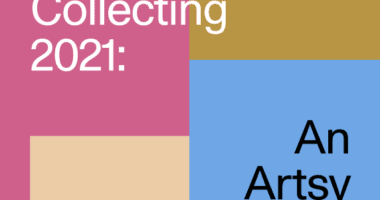
Anna Bjerger, Detail of Trunk, 2021. Courtesy of Galleri Bo Bjerggaard.
When someone visits your gallery for the first time and likes what they see, there’s a good chance they’ll sign up for your newsletter. As the most direct way to reach collectors en masse—and at a low cost—newsletters are widely used by galleries to promote exhibitions, share press coverage, and keep clients engaged via email.
But the length of your gallery’s mailing list only matters if collectors are actually clicking and opening your emails. Take a look at the performance of your recent sends: If the open rates are below 20% (the average across industries in November 2021), your emails could use a little help standing out in our increasingly crowded inboxes.
The key is in the subject line: The more compelling it is, the more clicks you’ll get, and therefore more conversion. Below, find our tips for writing successful subject lines—and try them in the next email you send, as well as all that follow.
1. Keep it short and simple
A great subject line is easy to scan and absorb. Be concise—the fewer words necessary, the better. Opt for shorter words, too: Most desktop inboxes display up to 60 characters of a subject line, while mobile inboxes show around 25–30 characters.
2. Frame it as a question
By addressing readers directly with a thought-provoking question, you can better catch their attention. For example:
- Press coverage: “Which artist has X publication talking?”
- Art fair: “We’re ready for The Armory Show. Are you?”
- Event: “Count you in for the X party?”
- Holiday: “Looking for something special?”
3. Captivate with a cliffhanger
Intrigue is often hard to resist—and from a marketing standpoint, curiosity has been proven to drive opens and clicks. A cliffhanger subject line can stand out in even the fullest of inboxes. For example:
- Featured solo show “Guess who’s back in New York… ”
- Art fair “Our best booth ever? See for yourself…”
4. Put yourself in your audience’s shoes
Ask yourself: Who are my subscribers, and what information is useful or interesting to them right now? How does this email relate to them? By thinking about these elements, you can craft quality subject lines that your audience will want to click on.
If you use an email marketing platform like Mailchimp or Hubspot, you can tailor emails more specifically through audience segmentation (e.g. by location, interests, or sale history) and/or personalization (e.g. a token to add someone’s name to the subject line).
Also, emails from “real people” tend to get more clicks than those from companies—so try putting an employee’s name as the sender (e.g. Pablo from The Painting Room).
5. Add deadlines to create urgency
Urgency is a consistent driver of engagement. When readers sense time running out, they feel more compelled to click so they don’t miss out on something exciting. For best results, pair with a clear call to action.
This strategy works especially well with event announcements or “closing soon” alerts. For example:
- Art fair “3 days left—don’t miss us at X!”
- Solo show “Your last chance to see X before she’s gone!”
- Opening “You won’t want to miss this opening—”
6. Brainstorm several options
Artsy’s marketing team drafts at least 10 potential subject lines for each email, and then choose our favorite. In your brainstorm, base your subject lines on learnings from previous email campaigns, such as those with high open rates or anecdotal feedback from your subscribers. Also, take the opportunity to experiment with style, angle, and tone.
7. Refer to your own inbox
Keep an archive of emails from publications, museums, and e-commerce sites that stand out to you and your team. The more emails you read, the more trends you’ll notice—the better your emails will stand out in a crowded inbox.
8. Try A/B testing
Email marketing platforms like MailChimp, Hubspot, and Constant Contact allow you to easily A/B test subject lines. This means some of your subscribers will get one subject line for an email, while others get a different subject line for the same email. Then, you can see which performed better (i.e. had a higher open rate)—and get new insights into the style, angle, and tone that your audience prefers.
We recommend these approaches to A/B testing:
- Approach 1: A/B test two subject lines between two small, equally sized cohorts of your audience. Then send the winning line to the rest of your subscribers.
- For example, say you have 3,500 subscribers. You send subject line A to 250 people, and subject line B to 250 people. If subject line A gets 60 more opens after 5 hours, you send subject line A to your remaining 3,000 subscribers.
- Approach 2: A/B test two subject lines among your whole audience. Send subject line A to half of your audience, and subject line B to the other half. Apply learnings to future subject lines. (Generally speaking, the more people an email goes out to, the more accurate your findings will be.)
9. Track performance—and get retroactive
Keep a record of your emails with the highest and lowest open rates, and pay attention to each subject line. What worked well, and what didn’t? Is there any correlation between high open rate and subject line construction, and vice versa?
After identifying the low-performing subject lines, try improving them based on the tips you’ve learned here—a good exercise for writing stronger subject lines going forward.
10. Don’t get sent to spam
Limit usage of common trigger words—in both the subject line and the bulk of the email—that can signal “spam” to email providers. Excessive punctuation, messy code, and no unsubscribe option can also land your emails in the spam folder.
11. Reflect your gallery’s brand
By aligning your subject lines with your gallery’s brand, you’ll create a more consistent experience for your clients.
Looking to convey a playful tone? Try using emojis, puns, or hashtags. Want to keep it more traditional? Consider using title case or sticking to complete sentences.



